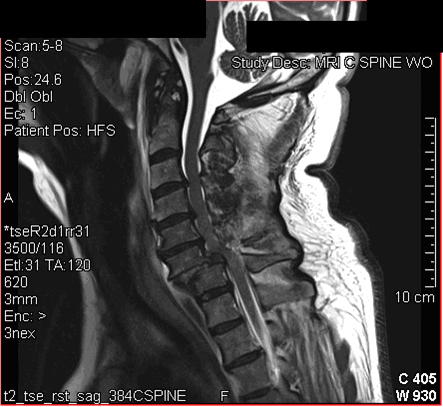Spinal Cord Injury is damage to the spinal cord, which is a cylindrical column of central neural tissue that descends from the brain down the spinal canal, from which peripheral nerves arise to deliver signals to every part of the body. Spinal cord injury occurs in about 12,000 people each year in the United States and in over 300,000 people each year in the world, and nearly 300,000 people in the United States are living with a spinal cord injury, along with over 3,000,000 people living with this injury in the world [1-3]. In addition to increased difficulty with activities of daily living, spinal cord injured patients also generally have medical complications involving chronic pain, bowel and bladder dysfunction, ulcers, and infections like pneumonia, urinary tract infections, and skin ulcer infections.
Injury to the spinal cord may occur from stretching, contusion, laceration, lack of blood flow (as in a stroke), or even from certain genetic or infectious diseases. The injury may be partial (only affecting some neural function below the lesion) or complete (destroying all neural function below the lesion). In traumatic injuries vertebrae are typically fractured or displaced, exerting compressive, tensile, and shear forces on the spinal cord tissue, and vascular injury (including hemorrhage or thrombosis) can further worsen the injury. Symptoms generally include paralysis, weakness, loss of sensation, and disturbances of autonomic function (such as that involving blood pressure, bowel and bladder function, or sexual function). Some temporary spinal incapacitation can result from swelling and inflammation after an acute injury, while additional neural death may also result from excitotoxicity, swelling, inflammation, and secondary messenger cascades after an injury, and therefore time is needed to assess the full extent and outcome of the injury. After time, glial scarring, demyelination, and cyst formation may also occur in the neural tissue. Efforts to find neuroprotective agents that can prevent further cell death and damage after the primary injury have been promising, but as of yet no drugs have been proven clincally effective for this approach in humans. Research is also underway to find innovative and useful therapeutic interventions that will improve or cure spinal cord injury, and, in particular, neural tissue engineering holds much potential to restore function to these patients. This includes unique and innovative efforts to reconstruct spinal cord pathways using 3-dimensional neural tissue with stem cells, biomaterials, signaling growth factors, and nanotechnology [4-7].
Several recent studies have begun investigating the use of patients' own bone marrow stem cells for both central and peripheral neural injury repair, including for spinal cord injuries, brain injuries, and nerve injuries. This appears to work by several mechanisms, including cellular repair and growth factors that stimulate axon regeneration, remyelination, and neural remodeling, while also having optimal safety of using your own cells to avoid foreign immune reactions or genetic manipulation [8-15]. Further information on these types of interventional therapies can also be found at Alpine Spine & Orthopedics Institute.
The image below shows an MRI of a traumatic cervical spine injury with severe compression of the spinal cord. (Image courtesy of Dr. McMurtrey)

-------------------
References:
1) National Spinal Cord Injury Statistical Center. Spinal cord injury facts and figures at a glance. J Spinal Cord Med. 36(1), 1, 2013.
2) Jackson AB, Dijkers M, Devivo MJ, Poczatek RB. A demographic profile of new traumatic spinal cord injuries: change and stability over 30 years. Arch Phys Med Rehabil. 85(11), 1740, 2004.
3) Wyndaele M, Wyndaele JJ. Incidence, prevalence and epidemiology of spinal cord injury: what learns a worldwide literature survey? Spinal Cord. 44(9), 523, 2006.
4) McMurtrey RJ. Patterned and Functionalized Nanofiber Scaffolds in 3-Dimensional Hydrogel Constructs Enhance Neurite Outgrowth and Directional Control. J. Neural Eng. 11 (2014) 066009. https://pubmed.ncbi.nlm.nih.gov/25358624/.
5) McMurtrey RJ. Novel Advancements in Three-Dimensional Neural Tissue Engineering and Regenerative Medicine. Neural Regeneration Research. 2015 Mar; 10(3). https://pubmed.ncbi.nlm.nih.gov/25878573/
6) McMurtrey RJ. Analytic Models of Oxygen and Nutrient Diffusion, Metabolism Dynamics, and Architecture Optimization in Three-Dimensional Tissue Constructs with Applications and Insights in Cerebral Organoids. Tissue Engineering Part C. 2015. https://pubmed.ncbi.nlm.nih.gov/26650970/
7) McMurtrey RJ. Roles of Diffusion Dynamics in Stem Cell Signaling and Three-Dimensional Tissue Development. https://pubmed.ncbi.nlm.nih.gov/28707964/.
8) A Phase III Clinical Trial Showing Limited Efficacy of Autologous Mesenchymal Stem Cell Therapy for Spinal Cord Injury. https://pubmed.ncbi.nlm.nih.gov/26891377/
9) Combining cell therapy with human autologous Schwann cell and bone marrow-derived mesenchymal stem cell in patients with subacute complete spinal cord injury: safety considerations and possible outcomes. https://pubmed.ncbi.nlm.nih.gov/34372939/
10) Neuro-glial differentiation of human bone marrow stem cells in vitro. https://pubmed.ncbi.nlm.nih.gov/15869934/
11) Bone marrow mesenchymal stem cells promote remyelination in spinal cord by driving oligodendrocyte progenitor cell differentiation via TNFα/RelB-Hes1 pathway. https://pubmed.ncbi.nlm.nih.gov/34348774/
12) Combining cell therapy with human autologous Schwann cell and bone marrow-derived mesenchymal stem cell in patients with subacute complete spinal cord injury: safety considerations and possible outcomes. https://pubmed.ncbi.nlm.nih.gov/34372939/
13) NeuroRegen Scaffolds Combined with Autologous Bone Marrow Mononuclear Cells for the Repair of Acute Complete Spinal Cord Injury: A 3-Year Clinical Study. https://pubmed.ncbi.nlm.nih.gov/32862715/
14) Cytokine polarized, alternatively activated bone marrow neutrophils drive axon regeneration. https://pubmed.ncbi.nlm.nih.gov/38811815/
15) Culturing neural and bone mesenchymal stem cells in photosensitive hydrogel enhances spinal cord injury repair. https://www.frontiersin.org/journals/bioengineering-and-biotechnology/articles/10.3389/fbioe.2024.1431420/full
16) A clinical trial report of autologous bone marrow-derived mesenchymal stem cell transplantation in patients with spinal cord injury. https://pubmed.ncbi.nlm.nih.gov/23935735/
-------------------
Copyright © 2014 Institute of Neural Regeneration & Tissue Engineering. All Rights Reserved.
Back to Education
| 